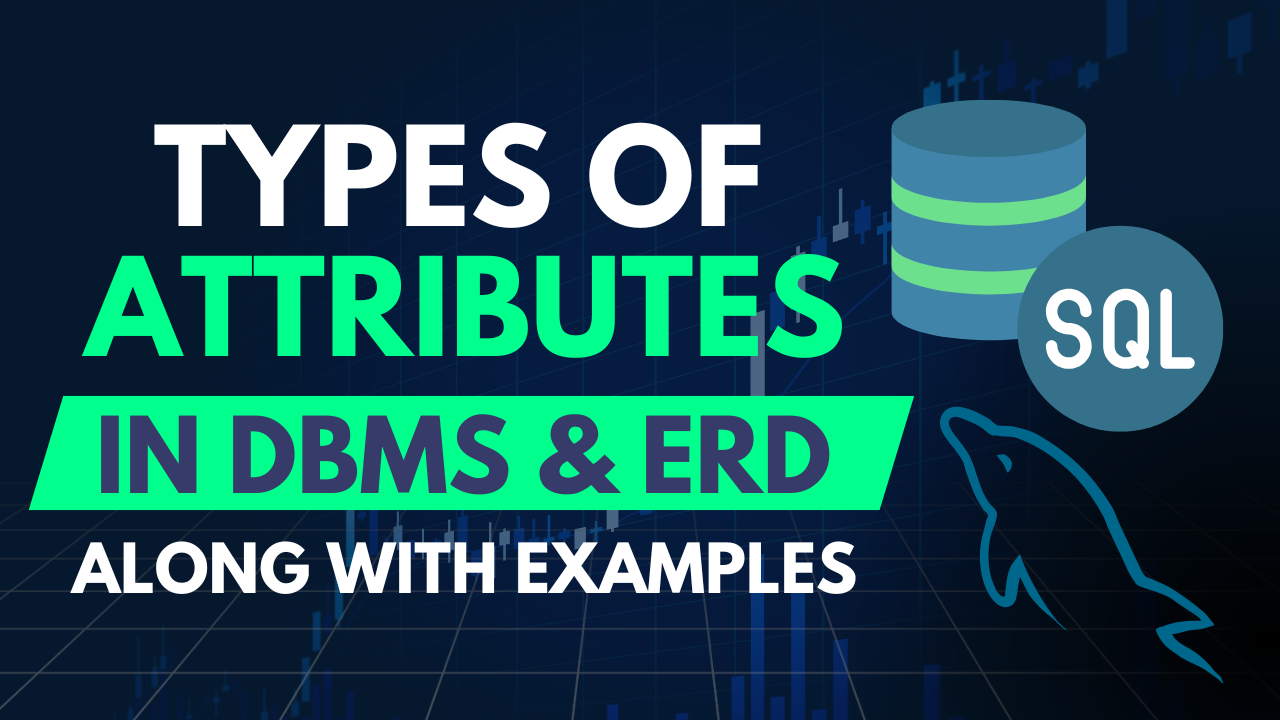Introduction
In database management systems (DBMS), an Attribute is a fundamental concept that cannot exist without the Entity concept. To understand attributes properly, we first need to grasp what an entity is, along with related terms like Entity Instance, Entity Set, and ER Diagrams.
This article will cover:
- Entity and Related Terms
- ER Diagrams (Brief Overview)
- Types of Attributes in DBMS (with examples for each)
- Tables, Comparisons, and Key Takeaways
Let’s dive in!
1. Understanding Entity and Related Terms
What is an Entity?
An Entity is a real-world object, person, place, or concept that we represent in a database. It is usually a noun, such as Student, Employee, Product, etc.
Entity Instance
An Entity Instance refers to a single occurrence of an entity.
- Example: If Student is an entity, then “John” (a specific student) is an instance of that entity.
Entity Set
An Entity Set is a collection of all instances of an entity.
- Example: All students in a university database form the Student Entity Set.
2. ER Diagrams (Brief Overview)
An Entity-Relationship (ER) Diagram is a standardized way to visually represent the structure of a database. It shows:
- Entities (as rectangles)
- Relationships (as diamonds)
- Attributes (as ovals)

Why Use ER Diagrams?
- Helps in database design before actual implementation.
- Ensures clarity for team members.
- Follows industry standards for better understanding.
(For a deeper dive into ER Diagrams, check online resources.)
3. Types of Attributes in DBMS
Attributes define the properties or characteristics of an entity. They are classified into different types based on their behavior and structure.
Here’s a breakdown of each type with examples:
1. Simple Attribute
- Definition: An attribute that cannot be divided further.
- Example:
- Student’s Roll Number (a single, indivisible value).
- Characteristics:
- Atomic (no sub-parts).
- Stored as a single field in a table.
2. Composite Attribute
- Definition: An attribute that can be split into smaller sub-attributes.
- Example:
- Student’s Address → Can be divided into Street, City, State, Zip Code.
- Characteristics:
- Improves data organization.
- Can be broken down for detailed analysis.
3. Single-Valued Attribute
- Definition: An attribute that holds only one value at a time.
- Example:
- Employee’s Date of Birth (only one DOB per employee).
- Characteristics:
- Ensures data integrity.
- Prevents redundancy.
4. Multi-Valued Attribute
- Definition: An attribute that can hold multiple values at once.
- Example:
- Employee’s Phone Numbers (a person may have multiple contact numbers).
- Characteristics:
- Represented with double ovals in ER diagrams.
- Requires separate tables in a relational database.
5. Derived Attribute
- Definition: An attribute whose value is derived from another attribute.
- Example:
- Employee’s Age (calculated from Date of Birth).
- Characteristics:
- Not stored directly in the database.
- Computed when needed.
6. Complex Attribute
- Definition: A combination of composite and multi-valued attributes.
- Example:
- Employee’s Education Details → Can include multiple degrees, each with Degree Name, University, Year.
- Characteristics:
- Nested structure.
- Requires careful database design.
7. Stored Attribute
- Definition: An attribute that is physically stored in the database.
- Example:
- Employee’s Salary (directly stored in the database).
- Characteristics:
- Used as a base for derived attributes.
8. Key Attribute
- Definition: An attribute that uniquely identifies an entity instance.
- Example:
- Student’s Roll Number (no two students can have the same roll number).
- Characteristics:
- Also called Primary Key.
- Ensures no duplicates.
9. Null Attribute
- Definition: An attribute with no value (either unknown or not applicable).
- Example:
- Employee’s Middle Name (if not provided, stored as NULL).
- Characteristics:
- Helps in handling missing data.
10. Descriptive Attribute
- Definition: An attribute that provides additional details about a relationship.
- Example:
- Enrollment Date (describes when a student enrolled in a course).
- Characteristics:
- Used in many-to-many relationships.
4. Comparison Table of Attribute Types
| Attribute Type | Description | Example |
|---|---|---|
| Simple | Cannot be divided | Roll Number |
| Composite | Can be split into sub-parts | Address (Street, City, Zip) |
| Single-Valued | Holds only one value | Date of Birth |
| Multi-Valued | Can have multiple values | Phone Numbers |
| Derived | Calculated from another attribute | Age (from DOB) |
| Complex | Mix of composite & multi-valued | Education Details |
| Stored | Physically stored in DB | Salary |
| Key | Uniquely identifies an entity | Roll Number |
| Null | No value assigned | Middle Name (NULL) |
| Descriptive | Describes a relationship | Enrollment Date |
5. Practical Example: Student Database
Let’s consider a Student Database to see how different attributes are used:
Entity: Student
| Attribute Type | Example |
|---|---|
| Simple | Student_ID (101) |
| Composite | Address (123 Street, Delhi, 110001) |
| Single-Valued | Date_of_Birth (2000-05-15) |
| Multi-Valued | Phone_No (9876543210, 9876543211) |
| Derived | Age (Calculated from DOB) |
| Key Attribute | Student_ID (Primary Key) |
6. Key Takeaways
✔ Attributes define the properties of an entity.
✔ Different types serve different purposes (e.g., Key Attribute ensures uniqueness).
✔ ER Diagrams help visualize database structure.
✔ Composite & Multi-Valued attributes need special handling in DB design.
Understanding attributes in DBMS is crucial for database design, normalization, and efficient data storage. By classifying attributes into different types, we can organize data better and avoid redundancy.
If you’re preparing for database-related interviews or working on a real-world project, mastering these concepts will give you a strong foundation.
For more DBMS tutorials, keep visiting allalboutml.com! 🚀

